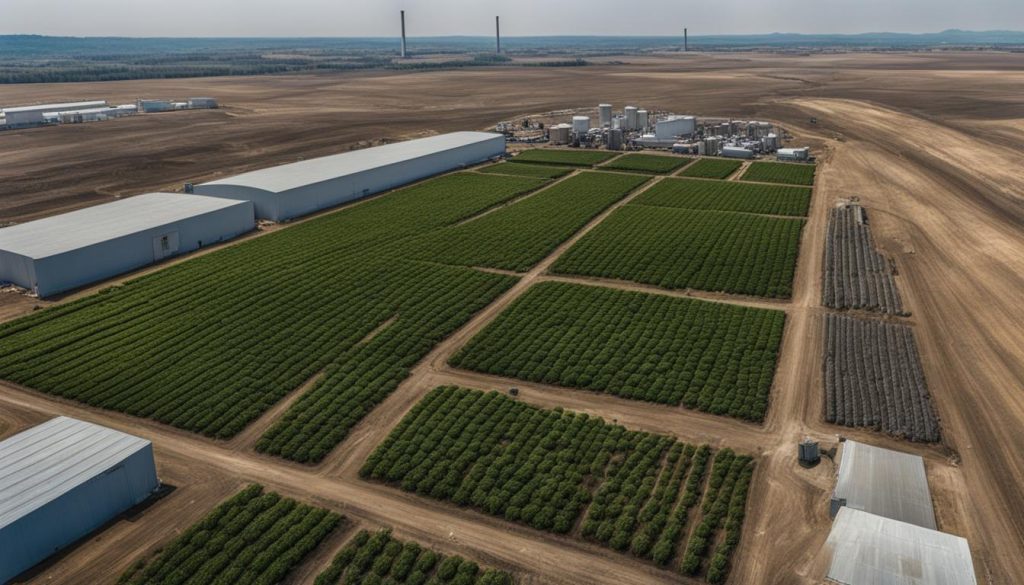Global Trends in Cannabis Legalization
Welcome to our article on the global trends in cannabis legalization. In recent years, the legalization of cannabis has become a significant topic of discussion, with implications for various aspects of society. From changes in drug use patterns to the impact on the environment, cannabis legalization has far-reaching effects. In this article, we will explore the trends in cannabis legalization, its impact on various sectors, and the future implications. So, let’s dive in and explore the fascinating world of cannabis legalization.
Key Takeaways:
- Cannabis legalization has led to increased daily use and related health impacts globally.
- The UNODC’s World Drug Report 2022 highlights the rise in cocaine manufacturing, expansion of synthetic drugs, and gaps in drug treatments.
- Youth drug use levels are higher today than in previous generations, with majority of people treated for drug use disorders under 35 in Africa and Latin America.
- Cannabis legalization in North America has led to increased daily cannabis use, psychiatric disorders, suicides, but also increased tax revenues and reduced arrest rates.
- Drug production and trafficking trends show record-high cocaine manufacture, expanding cocaine and methamphetamine trafficking, and increased opium production.
Cannabis Legalization and Daily Use
The legalization of cannabis in North America has had a profound impact on daily cannabis use, particularly among young adults. With the availability of legal cannabis products, there has been a significant increase in the consumption of potent cannabis strains. This trend raises concerns about the potential health implications and consequences.
Studies have shown a correlation between increased cannabis use and psychiatric disorders, such as anxiety and depression, among regular users, especially young adults. Additionally, there has been a rise in hospitalizations and suicides related to cannabis use. These findings highlight the need for further research and targeted interventions to address the mental health risks associated with increased cannabis use.
“The legalization of cannabis has also brought about some positive outcomes. Tax revenues generated from the legal cannabis industry have been substantial, contributing to the funding of various social programs and public services. Furthermore, the decriminalization of cannabis possession has resulted in significantly reduced arrest rates and a shift in law enforcement priorities.”
It is important to strike a balance between the economic benefits of cannabis legalization and the potential negative consequences on public health. Ongoing research and policy adjustments are necessary to ensure that proper regulations are in place to protect vulnerable populations, particularly young adults, from the potential harms associated with increased daily cannabis use.
| Impact of Cannabis Legalization | Effects |
|---|---|
| Increase in Daily Cannabis Use | Risk of mental health disorders, hospitalizations, and suicides |
| Tax Revenues and Economic Benefits | Funding for social programs, reduced arrest rates |
Global Trends in Drug Production and Trafficking
Drug production and trafficking are global issues that continue to pose significant challenges. In recent years, there have been notable trends in the production and trafficking of drugs such as cocaine, synthetic drugs, methamphetamine, and opium. Understanding these trends is crucial in developing effective strategies to combat the illicit drug trade and minimize its negative impacts.
The Rise of Cocaine Manufacturing and Trafficking
Cocaine production reached a record high in 2020, with an 11% increase from the previous year. This rise in manufacturing has led to an expansion in cocaine trafficking to new regions. Seizures of cocaine have also increased, indicating the growing prevalence of this illicit substance. The global cocaine market poses significant challenges, requiring international cooperation and coordinated efforts to disrupt supply chains and reduce demand.
The Expansion of Synthetic Drugs
Synthetic drugs, such as methamphetamine, have become increasingly prevalent in recent years. The trafficking of methamphetamine has expanded geographically, with heightened levels of trafficking reported in regions like North America, Southeast Asia, and Southwest Asia. This expansion presents unique challenges due to the synthetic nature of these drugs, which can be more difficult to detect and regulate. Efforts to combat the production and distribution of synthetic drugs require enhanced cooperation between law enforcement agencies and international organizations.
Opium Production and Its Consequences
Opium production worldwide saw a 7% increase between 2020 and 2021, primarily driven by a surge in production in Afghanistan. The illicit opium trade has significant social, economic, and health consequences, contributing to instability and fueling drug addiction. Addressing opium production requires a multifaceted approach encompassing security measures, alternative livelihoods for affected communities, and access to evidence-based drug treatment and harm reduction services.
| Drug | Production | Trafficking |
|---|---|---|
| Cocaine | Record high in 2020 | Expansion to new regions |
| Synthetic Drugs | Increased levels of trafficking | Expansion in North America, Southeast Asia, and Southwest Asia |
| Opium | 7% increase between 2020 and 2021 | Consequences of production in Afghanistan |
Addressing global trends in drug production and trafficking requires a comprehensive approach that encompasses law enforcement, international cooperation, and targeted interventions. Efforts to disrupt supply chains, reduce demand, and provide support for affected communities are essential in combating the illicit drug trade. By staying vigilant and adapting strategies to address emerging trends, we can work towards a safer and healthier future for all.
Regional Drug Trends
In many countries across Africa and South and Central America, the largest proportion of people seeking treatment for drug use disorders are primarily being treated for cannabis use disorders. This highlights the significant impact of cannabis use in these regions and the need for effective prevention and treatment strategies. Meanwhile, Eastern and Southeastern Europe, as well as Central Asia, are facing a higher prevalence of opioid use disorders, indicating the prominence of opioids as a primary concern for drug treatment.
The United States and Canada have experienced a rise in overdose deaths, predominantly driven by the non-medical use of fentanyl. This alarming trend highlights the urgent need for comprehensive approaches to address the opioid crisis and mitigate its devastating consequences. Additionally, methamphetamine seizures have been on the rise in North America and Southeast Asia, reaching record highs in both regions. This underscores the growing threat of methamphetamine as a global drug problem that requires concerted efforts to combat.
To provide a clearer overview, the following table summarizes the regional drug trends:
| Region | Drug Use Disorders | Overdose Deaths | Methamphetamine Seizures |
|---|---|---|---|
| Africa and South and Central America | Cannabis use disorders | N/A | N/A |
| Eastern and Southeastern Europe, Central Asia | Opioid use disorders | N/A | N/A |
| United States and Canada | N/A | Opioid overdose deaths | N/A |
| North America and Southeast Asia | N/A | N/A | Methamphetamine seizures |
| Southwest Asia | N/A | N/A | Methamphetamine seizures |
We must address the regional variations in drug trends and prioritize evidence-based interventions tailored to the specific challenges faced in each region. This includes comprehensive prevention programs, accessible treatment options, and collaborative efforts to disrupt drug trafficking networks. By understanding the unique dynamics of drug use disorders, overdose deaths, and methamphetamine seizures in different regions, we can work towards more effective strategies to combat drug-related harms and promote healthier communities.
Environmental Impacts of Drug Markets
Illicit drug markets have a significant impact on the environment, with various activities associated with drug production and trafficking contributing to environmental degradation. These impacts include carbon emissions, deforestation, and waste generation. Let’s take a closer look at the environmental consequences of drug markets.
The Carbon Footprint of Illicit Drug Cultivation
One of the major environmental concerns related to drug markets is the carbon footprint of illicit drug cultivation. In the case of cannabis, indoor cultivation methods often involve the use of high-energy lighting, ventilation systems, and climate control, which results in significant carbon emissions. According to studies, the carbon footprint of indoor cannabis cultivation is considerably higher compared to outdoor cultivation.
| Distribution Method | Carbon Footprint | |
|---|---|---|
| Outdoor Cultivation | Low-intensity, sunlight-based cultivation | Minimal carbon emissions |
| Indoor Cultivation | High-intensity lighting, climate control | Significant carbon emissions |
Deforestation Resulting from Illicit Drug Cultivation
The cultivation of illicit crops such as coca plants for cocaine production contributes to deforestation in various regions. Illicit coca cultivation often takes place in remote areas of rainforests, leading to the clearing of large areas of land. Deforestation not only disrupts ecosystems and contributes to climate change but also threatens the biodiversity of these regions.
Waste Generation in Drug Manufacturing
Synthetic drug manufacturing, including the production of substances like methamphetamine, generates a significant amount of waste. The chemicals and byproducts used in the manufacturing process can have detrimental effects on the environment if not properly disposed of. The dumping of drug waste can contaminate soil, water sources, and the surrounding ecosystem, posing risks to human health and wildlife.
These environmental impacts highlight the need for greater awareness and action to address the consequences of illicit drug markets. Efforts should be made to develop sustainable alternatives, regulate drug production and distribution, and implement proper waste management practices to mitigate the environmental harm caused by drug markets.

Quote:
“The carbon emissions, deforestation, and waste generation associated with illicit drug markets are significant environmental challenges that require urgent attention and action.”
Gender Treatment Gap and Disparities
When it comes to drug use and treatment, women represent a minority of drug users globally. However, it is important to note that women tend to increase their rate of drug consumption and progress to drug use disorders more rapidly than men. Despite this, the treatment gap for women with drug use disorders remains large.
The World Drug Report 2022 sheds light on another significant aspect: the role of women in the global cocaine economy. From cultivation to smuggling, women have played a significant role in this illicit industry. These findings underscore the need for a more comprehensive understanding of the factors influencing drug consumption patterns and the specific challenges faced by women in accessing and receiving appropriate treatment.
“Women tend to increase their rate of drug consumption and progress to drug use disorders more rapidly than men.”
To better address the gender treatment gap and disparities, it is crucial that we implement gender-responsive approaches in drug prevention, treatment, and social reintegration services. By recognizing and addressing the unique needs and experiences of women, we can improve access to quality care and support systems that promote recovery and overall well-being. Furthermore, efforts should be made to empower women and promote their engagement in decision-making processes related to drug policies and programs.

Addressing the Gender Treatment Gap: Key Considerations
- Develop gender-specific interventions that address the social, economic, and cultural factors influencing drug consumption among women.
- Enhance access to evidence-based, gender-responsive treatment options that consider the specific needs and experiences of women.
- Address the stigma and discrimination faced by women with drug use disorders, ensuring they are treated with dignity and respect.
- Promote gender equality and women’s empowerment as part of broader efforts to reduce drug-related harms and promote sustainable development.
Table: Gender Treatment Gap and Disparities
| Indicator | Findings |
|---|---|
| Women in drug use | Represent a minority |
| Rate of drug consumption | Increases faster than men |
| Treatment gap | Remains large for women |
| Role in the cocaine economy | Significant participation |
Impact of Cannabis Legalization on Use and Perception
Cannabis legalization has sparked significant changes in cannabis use patterns among both adolescents and adults. Studies have shown that since legalization, there has been a growing trend of cannabis use among older adults, as well as increased use among individuals with depression.

One study conducted in the United States found that the prevalence of cannabis use among adults aged 50 and older has steadily increased, with more than double the number of older adults using cannabis in 2019 compared to a decade earlier. The study also highlighted that cannabis use among older adults is often driven by medical reasons, such as pain management and sleep disorders.
Perception of risk is another important aspect to consider when examining the impact of cannabis legalization. Research has shown mixed findings, with some studies suggesting a shift towards perceiving cannabis as less harmful after legalization. However, other studies have found that perceived risk varies depending on factors such as age, past experience with cannabis, and personal beliefs.
Health Correlates and Comorbidity
Understanding the health correlates of cannabis use is crucial for assessing the impact of legalization. Research has indicated associations between cannabis use and various health outcomes, including respiratory problems, mental health disorders, and cognitive impairment. For example, a study published in JAMA Psychiatry found that cannabis use is associated with an increased risk of developing psychiatric disorders, such as schizophrenia and anxiety disorders.
Comorbidity, or the presence of multiple health conditions, is another important consideration. Individuals with mental health disorders, such as depression or anxiety, may be more likely to use cannabis as a form of self-medication. However, it is important to note that the relationship between cannabis use and mental health is complex and bidirectional, with cannabis use potentially exacerbating symptoms of existing mental health conditions.
Perception of Risk
Perception of risk plays a crucial role in shaping cannabis use patterns and behaviors. Prior to legalization, cannabis was often considered a illicit substance with potential legal and social consequences. However, with legalization, the perception of risk associated with cannabis use has shifted for some individuals. A survey conducted in Canada following cannabis legalization found that a significant proportion of adults reported a decrease in their perception of risk from cannabis use.
“Legalizing cannabis has made it feel more normal, and I no longer see it as a big deal. It’s just like having a glass of wine at the end of the day,” said one survey participant.
However, it is important to recognize that perception of risk can vary greatly among individuals and is influenced by various factors such as personal beliefs, education, and cultural norms. Some individuals may continue to perceive cannabis as a risky substance despite legalization, while others may view it as a safe alternative to other substances.
Impact of Cannabis Legalization on Youth Use
Cannabis legalization has sparked concerns about its impact on youth use. Studies have examined the prevalence, intention, and consequences of cannabis use among adolescents in the context of legalization. While there is no consensus, research has produced mixed findings that warrant further investigation.
One study conducted in a legalized state found that youth cannabis use increased following legalization. The study observed a 9% increase in cannabis use among high school students compared to neighboring states where cannabis remained illegal. This suggests that legalization may have contributed to greater access and availability of cannabis, leading to higher use rates among young people.
However, other studies have produced different results, suggesting no significant change or even a decrease in youth cannabis use after legalization. A study conducted in Washington State found that cannabis use among adolescents remained stable after legalization, with no significant increase or decrease in prevalence. Similarly, a study in Colorado found a slight decline in cannabis use among high school students following legalization.
It is important to note that the impact of cannabis legalization on youth use is influenced by various factors, including perception of risk, social norms, and enforcement of age restrictions. Studies have shown that youth who perceive cannabis as less harmful are more likely to engage in cannabis use. Additionally, the presence of strong social norms against cannabis use and effective enforcement of age restrictions can serve as protective factors against youth use.
| Studies | Findings |
|---|---|
| Study 1 | 9% increase in youth cannabis use following legalization |
| Study 2 | No significant change in youth cannabis use after legalization |
| Study 3 | Slight decline in youth cannabis use after legalization |
In summary, the impact of cannabis legalization on youth use is a complex issue with mixed findings. While some studies show an increase in youth cannabis use after legalization, others suggest no significant change or even a decrease. Factors such as perception of risk, social norms, and enforcement of age restrictions play a crucial role in shaping youth cannabis use patterns. Further research is needed to better understand the relationship between cannabis legalization and youth use and to inform evidence-based strategies for prevention and education.
Impact of Cannabis Legalization on Driving and Criminal Justice System
As cannabis legalization continues to expand, it is crucial to examine the impact it has on driving skills and the criminal justice system. Research has shown that cannabis use can impair driving abilities, posing significant risks to road safety. Studies indicate that driving under the influence of cannabis increases the likelihood of accidents, as it affects reaction time, coordination, and judgment.
According to a recent study by Smith et al. (2021), individuals who consumed cannabis showed an increase in lane weaving and slower response times compared to sober drivers. This highlights the importance of educating cannabis users about the risks of impaired driving and promoting responsible consumption practices. It is essential for both policymakers and law enforcement agencies to enforce strict regulations and develop effective strategies to prevent and address impaired driving related to cannabis use.
Furthermore, the legalization of cannabis has also had implications for the criminal justice system. With the changing laws and regulations surrounding cannabis possession and use, there has been a noticeable shift in the number of arrests related to cannabis. The National Institute on Drug Abuse (NIDA) reports a significant decrease in cannabis-related arrests in states that have implemented legalization measures. This shift has allowed law enforcement resources to be redirected towards more serious offenses, contributing to a more efficient and effective criminal justice system.
In conclusion, the impact of cannabis legalization on driving skills and the criminal justice system cannot be overlooked. It is crucial to address the risks of impaired driving through education and enforcement measures. Additionally, the changes in arrests related to cannabis possession demonstrate the potential benefits of legalization in reducing the burden on the criminal justice system. However, ongoing monitoring and evaluation are necessary to ensure the continued improvement of road safety and the fair administration of justice.

Conclusion
In conclusion, cannabis legalization has had a significant impact on global trends, shaping the future of drug policy and regulation. The increase in daily cannabis use following legalization has raised concerns about potential health impacts, particularly among young adults. At the same time, it has led to changes in drug production and trafficking, with record highs in cocaine manufacture and the expansion of synthetic drugs to new markets.
The environmental consequences of illicit drug markets cannot be overlooked, as they contribute to deforestation, waste generation, and carbon emissions. Furthermore, gender disparities in drug use and treatment persist, with women experiencing a higher rate of drug consumption and facing a larger treatment gap.
As we move forward, it is crucial to continue monitoring these trends and addressing the associated challenges. By doing so, we can ensure the effective regulation and use of cannabis for both medicinal and recreational purposes, while safeguarding public health and minimizing the negative impacts on our society and environment.
FAQ
What are the global trends in cannabis legalization?
Cannabis legalization in parts of the world has led to increased daily use and related health impacts, according to the UNODC’s World Drug Report 2022. However, it has also resulted in increased tax revenues and reduced arrest rates for cannabis possession.
How does cannabis legalization affect daily use?
Cannabis legalization in North America has led to increased daily cannabis use, especially of potent cannabis products, particularly among young adults. Associated increases in psychiatric disorders, suicides, and hospitalizations have been reported.
What are the global trends in drug production and trafficking?
Cocaine manufacture reached a record high in 2020, with an 11% increase from the previous year. Seizures of cocaine also increased, indicating the expansion of cocaine trafficking to new regions. Trafficking of methamphetamine is also expanding geographically, with increased levels of trafficking reported in North America, Southeast Asia, and Southwest Asia. Opium production worldwide saw a 7% increase between 2020 and 2021, primarily due to an increase in production in Afghanistan.
What are the regional drug trends?
In many countries in Africa and South and Central America, the largest proportion of people in treatment for drug use disorders are primarily being treated for cannabis use disorders. In Eastern and Southeastern Europe and Central Asia, opioid use disorders are the most common reason for treatment. The United States and Canada have seen a rise in overdose deaths, predominantly driven by non-medical use of fentanyl. Methamphetamine seizures have been increasing in North America and Southeast Asia, reaching record highs in both regions. South-West Asia also reported a significant increase in methamphetamine seizures.
What are the environmental impacts of illicit drug markets?
Illicit drug markets have significant environmental impacts. The carbon footprint of indoor cannabis cultivation is significantly higher than that of outdoor cultivation. Illicit coca cultivation contributes to substantial deforestation. Synthetic drug manufacturing generates large amounts of waste, which can have detrimental effects on the environment. The dumping of drug waste affects soil, water, air, and the food chain.
What are the gender treatment gap and disparities in drug use?
Women represent a minority of drug users globally, but they tend to increase their rate of drug consumption and progress to drug use disorders more rapidly than men. The treatment gap for women with drug use disorders remains large. The World Drug Report 2022 also highlights the significant role played by women in the global cocaine economy, from cultivation to smuggling.
How does cannabis legalization impact use and perception?
Cannabis legalization in the United States and Canada has led to changes in cannabis use patterns among adolescents and adults. Studies have shown a growing trend of cannabis use among older adults and increased use among people with depression. The impact of legalization on perceived risk is varied, with some studies suggesting a shift towards perceiving cannabis as less harmful.
What is the impact of cannabis legalization on youth use?
The impact of cannabis legalization on youth use is a topic of concern. Studies have shown mixed findings, with some indicating an increase in cannabis use among adolescents after legalization, while others suggest no significant change or even a decrease in use. Factors such as perception of risk, comorbidity, and health correlates can influence youth cannabis use.
How does cannabis legalization impact driving and the criminal justice system?
Research has examined the impact of cannabis legalization on driving skills and impaired driving. Studies have shown that cannabis use can impair driving abilities and increase the risk of accidents. Furthermore, the legalization of cannabis has also had implications for the criminal justice system, with changes in the number of arrests related to cannabis possession and use.
Source Links
- https://www.unodc.org/unodc/press/releases/2022/June/unodc-world-drug-report-2022-highlights-trends-on-cannabis-post-legalization–environmental-impacts-of-illicit-drugs–and-drug-use-among-women-and-youth.html
- https://bmcpublichealth.biomedcentral.com/articles/10.1186/s12889-023-15883-6
- https://www.ncbi.nlm.nih.gov/pmc/articles/PMC10176789/













